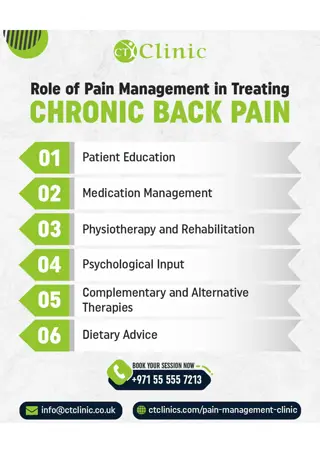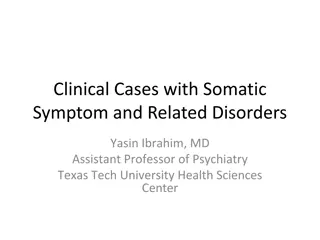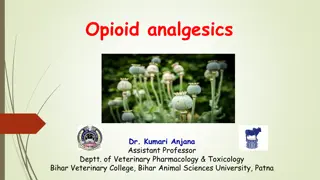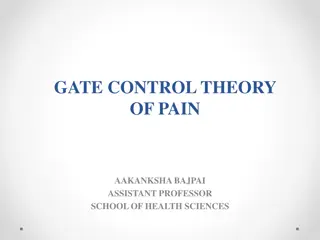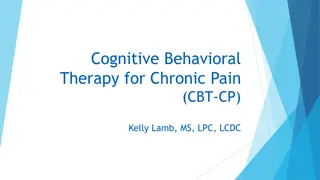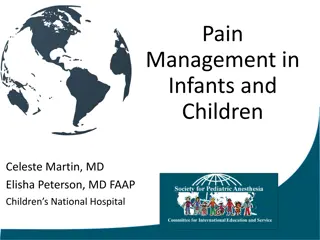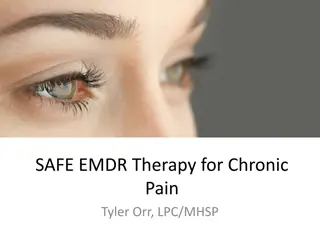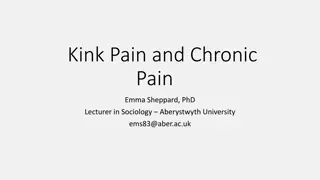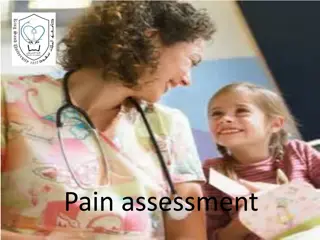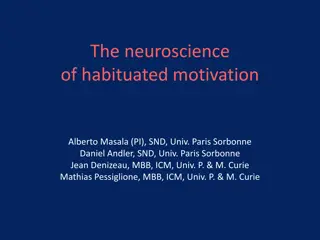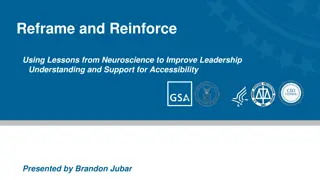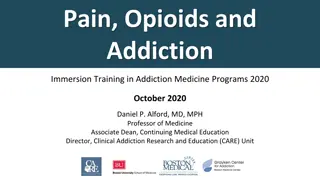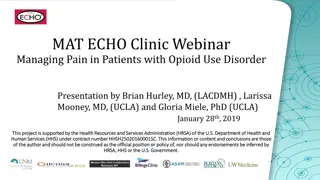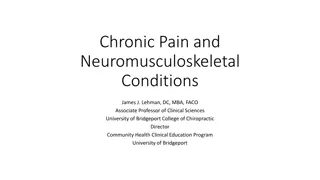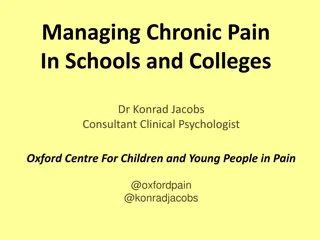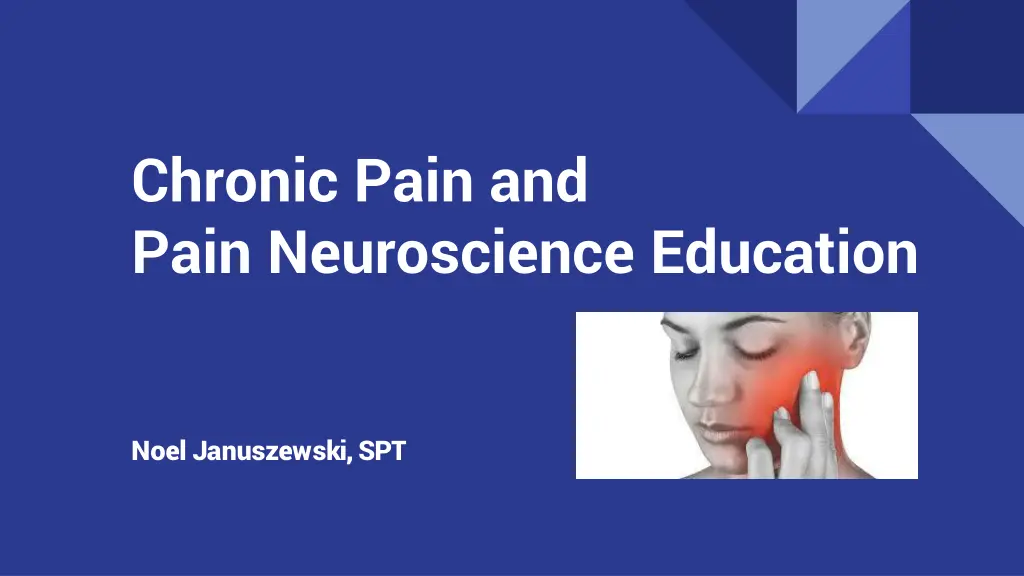
Understanding Chronic Pain and Pain Neuroscience Education
Explore the intricacies of chronic pain, including distinctions between chronic and acute pain, statistics, and biopsychosocial versus biomedical approaches. Delve into the physiological changes and psychosocial factors influencing pain experiences.
Download Presentation

Please find below an Image/Link to download the presentation.
The content on the website is provided AS IS for your information and personal use only. It may not be sold, licensed, or shared on other websites without obtaining consent from the author. If you encounter any issues during the download, it is possible that the publisher has removed the file from their server.
You are allowed to download the files provided on this website for personal or commercial use, subject to the condition that they are used lawfully. All files are the property of their respective owners.
The content on the website is provided AS IS for your information and personal use only. It may not be sold, licensed, or shared on other websites without obtaining consent from the author.
E N D
Presentation Transcript
Chronic Pain and Pain Neuroscience Education Noel Januszewski, SPT
Learning objectives At the conclusion of this inservice, listeners will be able to 1. Recall at least one pain analogy so that they can apply it to patient care. 2. Recall at least three key physiologic changes that occur in individuals with chronic pain. 3. Explain the importance of graded exposure for individuals with chronic pain. 4. Identify at least 3 lifestyle modifications that can be beneficial for individuals with chronic pain.
Chronic vs. Acute Pain Acute: Present for less than 3 months Occurs during the normal healing process after an injury or surgery Chronic: Lasts longer than 3 months Persists after tissue healing occurs Can be present in an area that has experienced previous trauma or even one that has not
Chronic Pain Statistics Prevalence In 2021, 21% of Americans had chronic pain (over 50 million) Cost An average of 16 lost work days per year from chronic pain $560-$635 billion total cost for the care of chronic pain patients in the US in 2010
Biopsychosocial vs. Biomedical Approach Biomedical Focuses on the physical and biological aspects of a condition A logical flow from diagnosis to treatment to cure Biopsychosocial Focuses on the physical and biological aspects while also including psychosocial aspects such as behavior, social support, education, and financial resources Biopsychosocial inputs can lead to pain outputs
Physiologic Changes Decreased descending inhibition Hypersensitivity Increased excitatory neurotransmitters and decreased inhibitory neurotransmitters Reduced action potential thresholds All lead to central sensitization or heightened pain from CNS mechanisms often independent from peripheral injury
Psychosocial Factors in Childhood Physical, emotional, or sexual abuse Physical or emotional neglect Household dysfunction including: Mental illness Incarcerated relatives Substance abuse Domestic violence Divorce
Psychosocial Factors in Adulthood Behavior Physical and Mental Health Issues Anxiety and Depression Obesity Heart Disease Stroke Lack of physical activity Alcohol and drug abuse Smoking Missed work
Outcome Measures 1. Chronic Pain Grade Scale (CPGS) 7 questions (1 present time pain intensity question, 1 chronic pain intensity question, and 5 pain impact questions over the last 6 months) Pros: Assesses chronic pain in relation to current pain and ADL impact and is quick to administer Cons: Recency bias and it does not ask many questions 2. Pain Catastrophizing Scale 13 questions (3 subscales covering rumination, magnification, and helplessness) Pros: More questions than the CPGS yet still quick to take Cons: No definitive timeline of when the pain occurred
Pain Neuroscience Education Pain Neuroscience Education helps patients understand their pain by educating them about: Basic pain neurophysiology How chronic pain differs from acute pain How pain is an output and not an input Factors that can contribute to chronic pain Steps they can take toward reducing their pain
How to Educate Validate the patient; let them know that their pain is real and not just something that is made up in their head Don t talk down to the patient and make sure that these complex medical processes are discussed in the simplest way possible Provide multiple methods that the patient can use to improve their quality of life: Easier understanding about their pain from the use of analogies Lifestyle modifications Interventions that show them movement is OK
Analogies 1. The sensitive fire alarm -introduces the patient to the idea of central sensitization 2. Calming this sensitized system -teaches patients about the importance that proper movement and activity can have on desensitization 3. The lion in the room -how stress can affect chronic pain 4. Tissue healing vs. pain -teaches patients that something on imaging doesn t automatically equal pain and vice versa
Lifestyle Modifications Breathing -mouth and chest breathing vs. pursed lip and diaphragmatic breathing Posture Sleep -the major role sleep hygiene plans on many aspects of our life including pain management Stress reduction -one thing at a time can equal a big win Anger vs. Forgiveness Diet and exercise -both the physiologic and psychologic effects Fear of movement
Interventions Graded activity progression -a chronic low back pain example
Resources for clinicians Back in Control: A Surgeon s Roadmap Out of Chronic Pain by David Hanscom, MD Explain Pain (Second Edition) by David Butler and Lorimer Moseley. Lotze M, Moseley G. Theoretical Considerations for Chronic Pain Rehabilitation. Physical Therapy. 2015 Sept;95(9):1316-1320.
Resources for patients Tame the Beast https://www.tamethebeast.org/#tame- the-beast Provides patients with videos that explain chronic pain in a simple, easy-to-understand way Archive of dozens of real-life stories of recovery from chronic pain directly from the individuals that patients can listen to Useful resources, individual coaching, and free courses
References 1. Harte SE, Harris RE, Clauw DJ. The neurobiology of central sensitization. J Appl Biobehav Res. 2018;23(2):e12137. doi:10.1111/jabr.12137 2. https://www.rwjf.org/en/building-a-culture-of-health/focus-areas.html#1 3. https://my.clevelandclinic.org/health/diseases/4798-chronic-pain 4. Rikard SM, Strahan AE, Schmit KM, Guy GP Jr.. Chronic Pain Among Adults United States, 2019 2021. MMWR Morb Mortal Wkly Rep 2023;72:379 385. DOI: http://dx.doi.org/10.15585/mmwr.mm7215a1. 5. Henschke N, Kamper SJ, Maher CG. The epidemiology and economic consequences of pain. Mayo Clin Proc. 2015;90(1):139-147. doi:10.1016/j.mayocp.2014.09.0 6. Farre A, Rapley T. The New Old (and Old New) Medical Model: Four Decades Navigating the Biomedical and Psychosocial Understandings of Health and Illness. Healthcare (Basel). 2017 Nov 18;5(4):88. doi: 10.3390/healthcare5040088. PMID: 29156540; PMCID: PMC5746722. 7. Adams LM, Turk DC. Central sensitization and the biopsychosocial approach to understanding pain. J Appl Biobehav Res. 2018;23(2):e12125. doi:10.1111/jabr.12125 8. Latremoliere A, Woolf CJ. Central sensitization: a generator of pain hypersensitivity by central neural plasticity. J Pain. 2009;10(9):895-926. doi:10.1016/j.jpain.2009.06.012 9. Edwards RR, Dworkin RH, Sullivan MD, Turk DC, Wasan AD. The role of psychosocial processes in the development and maintenance of chronic pain. J Pain. 2016;17(9 Suppl):T70-92. doi:10.1016/j.jpain.2016.01.001
References 10. https://www.physio-pedia.com/Chronic_Pain_Grade_Scale_(CPGS) 11. https://www.sralab.org/rehabilitation-measures/chronic-pain-grade-scale 12. Siengsukon CF, Al-Dughmi M, Stevens S. Sleep health promotion: practical information for physical therapists. Phys Ther. 2017;97(8):826-836. doi:10.1093/ptj/pzx057 13. Jafari H, Gholamrezaei A, Franssen M, et al. Can slow deep breathing reduce pain? an experimental study exploring mechanisms. J Pain. 2020;21(9-10):1018-1030. doi:10.1016/j.jpain.2019.12.010 14. Joseph AE, Moman RN, Barman RA, et al. Effects of Slow Deep Breathing on Acute Clinical Pain in Adults: A Systematic Review and Meta-Analysis of Randomized Controlled Trials. J Evid Based Integr Med. 2022;27:2515690X221078006. doi:10.1177/2515690X221078006 15. Nijs J, D Hondt E, Clarys P, et al. Lifestyle and Chronic Pain across the Lifespan: An Inconvenient Truth? PM R. 2020;12(4):410-419. doi:10.1002/pmrj.12244 16. Vaegter HB, Jones MD. Exercise-induced hypoalgesia after acute and regular exercise: experimental and clinical manifestations and possible mechanisms in individuals with and without pain. Pain Rep. 2020;5(5):e823. doi:10.1097/PR9.0000000000000823 17. Nijs J, Paul van Wilgen C, Van Oosterwijck J, van Ittersum M, Meeus M. How to explain central sensitization to patients with unexplained chronic musculoskeletal pain: practice guidelines. Man Ther. 2011;16(5):413-418. doi:10.1016/j.math.2011.04.005 18. George SZ, Zeppieri G. Physical therapy utilization of graded exposure for patients with low back pain. J Orthop Sports Phys Ther. 2009;39(7):496-505. doi:10.2519/jospt.2009.2983
References 19. Karaman S, et al. Prevalence of Sleep Disturbance in Chronic Pain. European Review for Medical and Pharmacological Sciences (2014); 18: 2475-2481. 20. Zarrabian MM, et al. Relationship between Sleep, Pain and Disability in Patients with Spinal Pathology. Archives of Physical Medicine and Rehabilitation (2014); 95: 1504-1509. 21. Carson JW, Keefe FJ, Goli V, Fras AM, Lynch TR, Thorp SR, Buechler JL. Forgiveness and chronic low back pain: a preliminary study examining the relationship of forgiveness to pain, anger, and psychological distress. J Pain. 2005 Feb;6(2):84-91. 22. Trost Z, et al. Cognitive Dimensions of Anger in Chronic Pain. Pain (2012);153: 515-517.
Questions? Thanks for listening!


